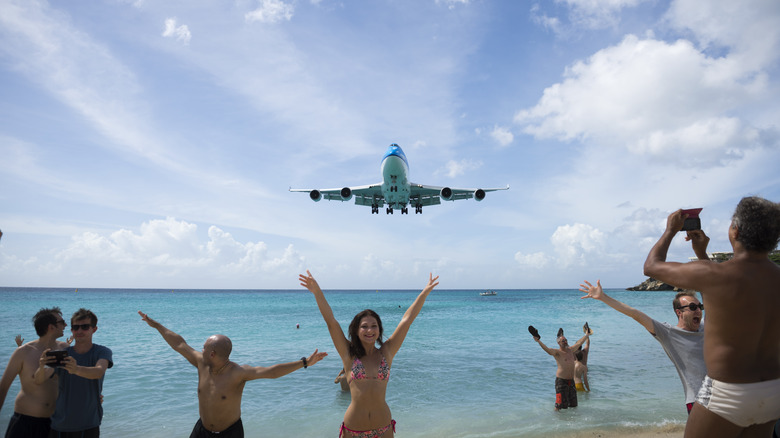Destinations Caribbean
Christine Estima
St. Martin: the Caribbean island so nice, they named it twice! The island is known by both the French name St. Martin, and the Dutch name Sint Maarten. That’s because both France and The Netherlands colonized the island in 1648, per The New York Times. The outlet reports the island has over 36 white-sand beaches despite the fact that it only clocks in at 96 square kilometers (or 37 square miles). Due to its small size, there was no space to put Princess Juliana International Airport in a secluded place. In fact, the airport has mountains on one end, and the popular Maho beach and beachside resorts on the other, where beachgoers come within meters of the landing and departing jets.
Enter the thrill-seekers. Videos are all over YouTube, showing the power of the jet blast as planes take off on the small 2,300-meter-long runway. Crowds on the beach hang onto the fence, in what’s known as “fence surfing,” their belongings flying off their bodies, and even entire groups of people are blown backward on the beach by the power of the jet blast. In addition, planes approaching the airport to land come dangerously close to beachgoers, with the landing gear seemingly coming mere meters from the tops of their heads.
It may sound like plain ol’ planespotting, but Princess Juliana International Airport is known as one of the scariest and most dangerous airports in the world. Here’s why planespotting on St. Martin could cost you your life.
A ‘fence-surfing’ tourist died from the close jet blast

Joel Carillet/Getty Images
Apart from the plethora of YouTube videos documenting just how violent “fence-surfing” can be, writer Amanda Macias described the experience. “The intensity of the blast knocked my body backward, the hot air stung, and the sand pelted my skin,” per Business Insider. New York-based photographer and St. Martin regular Eric Dunetz told CN Traveller, “Any given departure jet blast could be upwards of 100 mph, and the [danger] signs are there for a reason.” He’s not wrong. In 2017, a New Zealander tourist was killed when the jet blast from a departing plane knocked her backward, per The Independent. Dunetz says despite the clear danger and warning signs, the risk just isn’t worth it. “Most people don’t realize the danger they are potentially putting themselves in; they see it as a thrill-seeking opportunity.”
Travel journalist Cynthia Drescher agrees, telling The Independent, “I think those who come to the beach not knowing what they’re in for, being peer-pressured into joining others, are most at risk. The airport’s aviation operations aren’t dangerous. Being a human so near the end of a runway with planes taking off is.”
So while you may think this is an excellent opportunity to get some social media clout by standing directly behind a departing jet during take-off, maybe skip Maho Beach during your St. Martin holiday.

